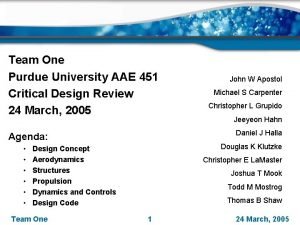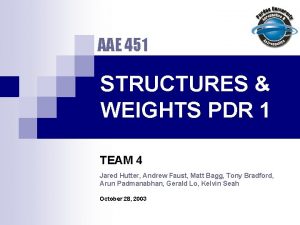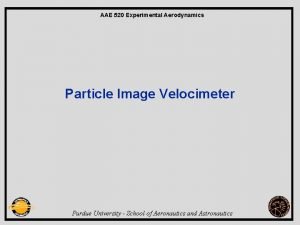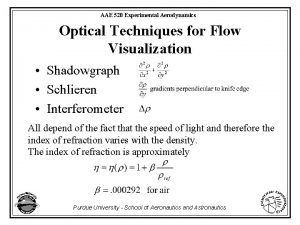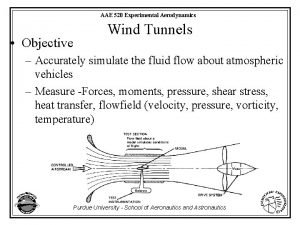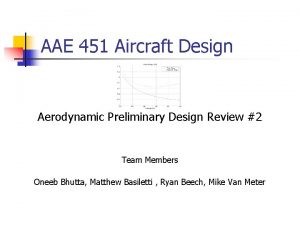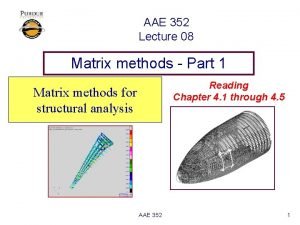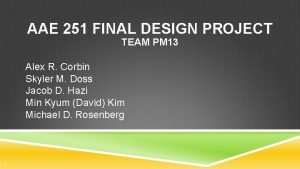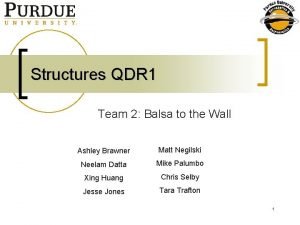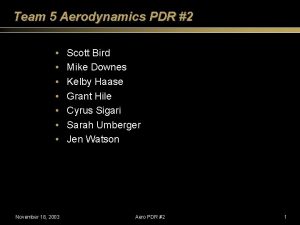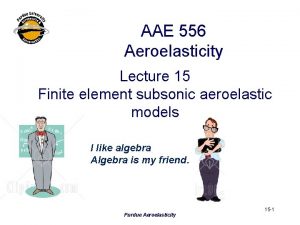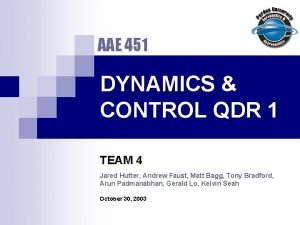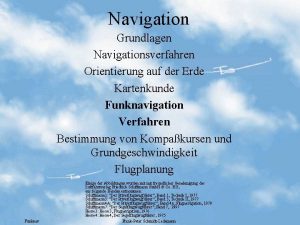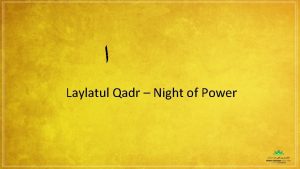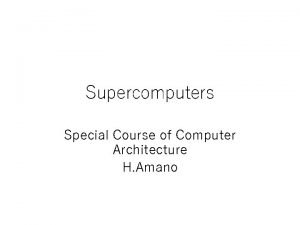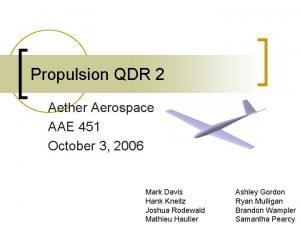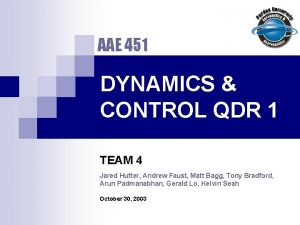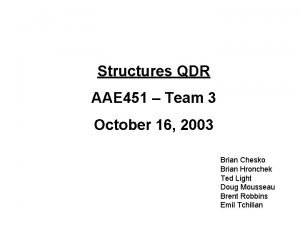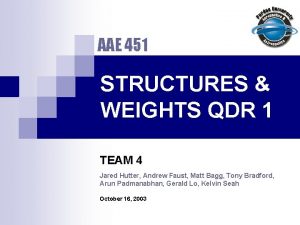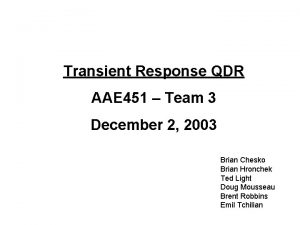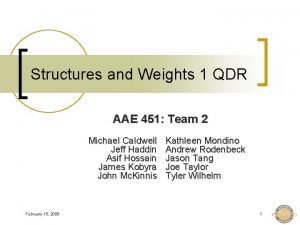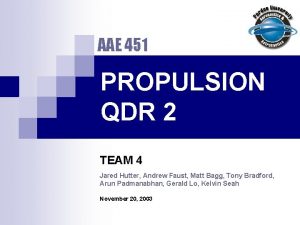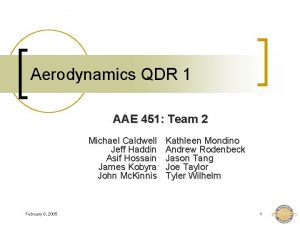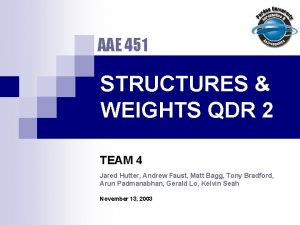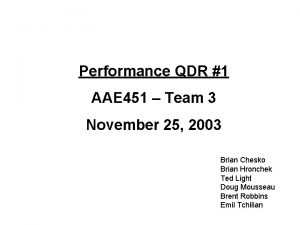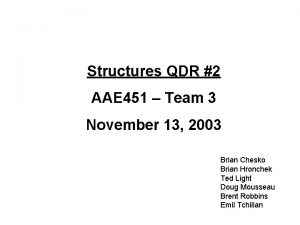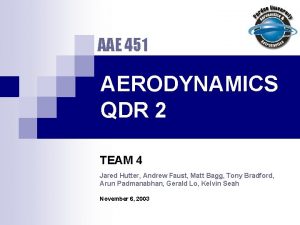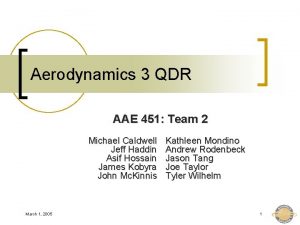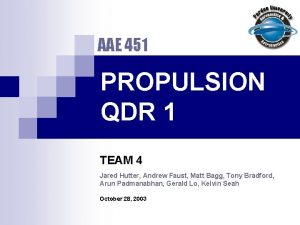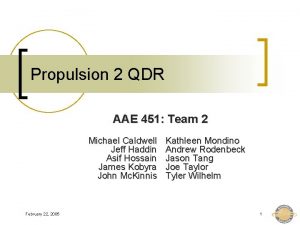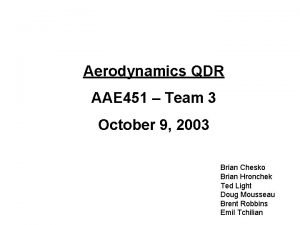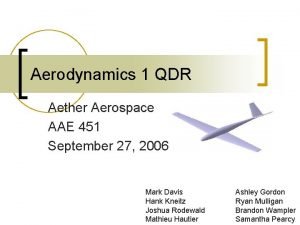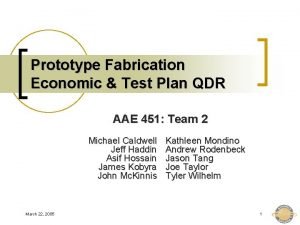AAE 451 DYNAMICS CONTROL QDR 3 TEAM 4





















- Slides: 21

AAE 451 DYNAMICS & CONTROL QDR 3 TEAM 4 Jared Hutter, Andrew Faust, Matt Bagg, Tony Bradford, Arun Padmanabhan, Gerald Lo, Kelvin Seah December 2, 2003

TEAM 4 OVERVIEW n Aircraft Walk-Around n Tail Re-Sizing n Stability Check n Modal Analysis n 6 -DOF Simulation

TEAM 4 CONCEPT REVIEW Empennage High Wing Horizontal and Vertical Tails S = 39. 3 ft 2 b = 14. 0 ft, c = 2. 8 ft AR = 5 UPDATED Avionics Pod 20 lb; can be positioned front or aft depending on requirements Twin Engine 1. 8 HP each Twin Booms 3 ft apart; 5. 7 ft from Wing MAC to HT MAC

TEAM 4 CONCEPT REVIEW Empennage High Wing Horizontal and Vertical Tails RESIZED S = 39. 3 ft 2 b = 14. 0 ft, c = 2. 8 ft AR = 5 UPDATED Avionics Pod 20 lb; can be positioned front or aft depending on requirements Twin Engine 1. 8 HP each Twin Booms 3 ft apart; 5. 7 ft from Wing MAC to HT MAC

TEAM 4 TAIL RE-SIZING n Horizontal and Vertical Tails were resized using updated Wing Geometry. n Modified Class 1 Approach: ¨ Fixed volume coefficients, get new tail size; ¨ Verified results with OEI yaw-trimming with rudder; ¨ Verified stability of modal responses; ¨ Iterated …

TEAM 4 TAIL RE-SIZING RESULTS VERTICAL TAIL HORIZONTAL TAIL = 9. 01 ft 2 1. 00 ft 1. 68 ft ½ = 1. 80 ft 2 2. 69 ft 1. 19 ft 3. 0 ft 1. 19 ft 5. 37 ft 1. 68 ft Volume Coefficients: Chord-wise Span-wise = 0. 50 • Elevator 0. 84 ft 2. 67 ft = 0. 04 • Rudder 0. 35 c. VT 2. 42 ft

TEAM 4 RUDDER DEFLECTION IN OEI CONDITIONS n Roskam (AAE 421 Textbook) n Required rudder deflection: FAR 23, 25 Limit Max Deflection n DRn. O: = 28 ft/s n Deflection Limit: n FAR 23, 25 requires that 1. 2 for = 0° n In this case, = 29. 57 ft/s Stall Speed Limit = 25°

TEAM 4 MODAL ANALYSIS n n Mode Poles Natural Frequency (rad/sec) Damping Ratio Dutch Roll -0. 86 ± j 1. 50 1. 73 0. 497 Lateral-Directional Subsystem Roll -5. 22 Spiral -0. 84 Side Velocity 0 Mode Poles Natural Frequency (rad/sec) Damping Ratio Phugoid -0. 05 ± j 0. 61 0. 084 0. 616 Longitudinal Subsystem Short Period -7. 59, -34. 80 Altitude ≈0

TEAM 4 MIL-F-8785 C GUIDELINES n Mode Poles Natural Frequency (rad/sec) Damping Ratio Dutch Roll -0. 86 ± j 1. 50 1. 73 0. 497 Lateral-Directional Subsystem Roll -5. 22 Spiral -0. 84 Side Velocity 0 0. 4, OK! 0. 08, OK! Stable, non-oscillatory – OK! Stable, does not diverge – OK! n Mode Poles Natural Frequency (rad/sec) Damping Ratio Phugoid -0. 05 ± j 0. 61 0. 084 0. 616 Longitudinal Subsystem Short Period -7. 59, -34. 80 Altitude ≈0 “Must be heavily damped” – OK!

TEAM 4 6 -DOF SIMULATION n The 6 -DOF motion was simulated in MATLAB. n Assumed flat earth, rigid body and steady winds. n Aircraft was trimmed at loiter conditions, and linearized the system about trim. n Comparisons between nonlinear and linear time responses: ¨ Elevator Step Input, e = 5° ¨ Aileron Step Input, a = 5° ¨ Rudder Step Input, r = 5°

TEAM 4 6 -DOF SIMULATION WITH ELEVATOR STEP INPUT

TEAM 4 6 -DOF SIMULATION WITH AILERON STEP INPUT

TEAM 4 6 -DOF SIMULATION WITH AILERON STEP INPUT

TEAM 4 6 -DOF SIMULATION WITH AILERON STEP INPUT

TEAM 4 6 -DOF SIMULATION WITH RUDDER STEP INPUT

TEAM 4 6 -DOF SIMULATION WITH RUDDER STEP INPUT

AAE 451 QUESTIONS?

AAE 451 APPENDIX

TEAM 4 RUDDER DEFLECTION IN OEI CONDITIONS ref. “Airplane Flight Dynamics and Automatic Flight Controls” (Roskam) Section 4. 2. 6 [rad] where @ 2, 000 ft for fixed pitch [slug/ft 3] V [ft/sec] P [hp] y. T [ft]

TEAM 4 IDENTIFICATION OF POLES n Lateral-Directional Subsystem Dutch Roll Mode n Only pole in this subsystem with both e and m parts. ¨ Roll Mode n Pole is negative; relatively large magnitude. ¨ Spiral Mode n Can be positive (in the case of the Predator), or negative. Small magnitude, so not typically a problem. ¨ Side Velocity Mode n Only pole in this subsystem that has zero magnitude. ¨

TEAM 4 IDENTIFICATION OF POLES n Longitudinal Subsystem Phugoid Mode n Complex conjugate pair. The m parts have a smaller magnitude than that of the other conjugate pair, indicating longer period (lower frequency). e parts are of small value, light damping. ¨ Short Period Mode n Complex conjugate pair. The m parts have a larger magnitude than that of the other conjugate pair, indicating shorter period (higher frequency). e parts are of larger value, heavier damping. ¨ Altitude Pole n Only pole in this subsystem that is purely real. ¨
 One.purdue
One.purdue Aae 508 purdue
Aae 508 purdue Aae 320
Aae 320 Aae 520
Aae 520 Aae 520
Aae 520 Aae 520
Aae 520 Aae design
Aae design Aae 352
Aae 352 Aae 320 uw madison
Aae 320 uw madison Aae 320
Aae 320 Aae 251 purdue
Aae 251 purdue Aae glass tutorial
Aae glass tutorial Aae 421
Aae 421 Subsonic 556
Subsonic 556 Aae 421
Aae 421 Qdm navigation
Qdm navigation Duas for laylatul qadr night
Duas for laylatul qadr night Special course amano
Special course amano Qdr aviation
Qdr aviation Team dynamics questionnaire higher pe
Team dynamics questionnaire higher pe Team dynamics france
Team dynamics france Going native project management
Going native project management
